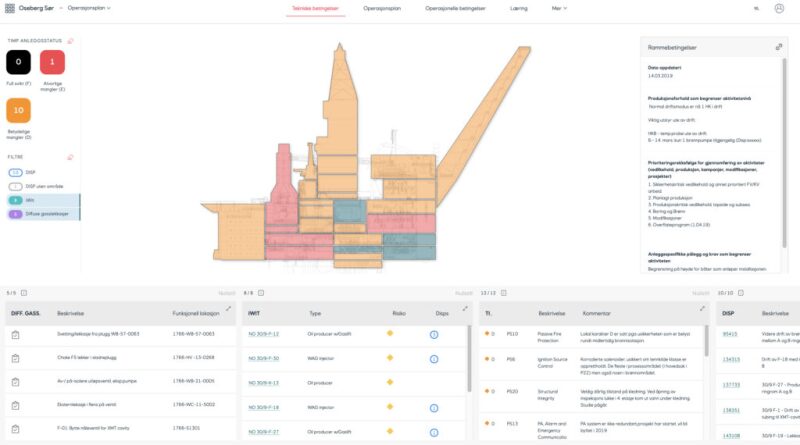Safe and efficient operations on an offshore facility require careful planning, often taking into account current conditions and the risk potential of any particular job.
In the past, Equinor manually consulted multiple data systems with separate user interfaces to get a view of a facility’s technical status and previous incidents. On top of the time-consuming nature of such work, planners still could not get a complete overview of the full asset status, leading planners to focus individually on the tasks within their disciplines.
To help alleviate these bottlenecks, Equinor developed its Operation Planning Tool (OPT) to provide a single interface displaying data from all of its sources, highlighting the technical barriers and incidents relevant to a planned job, as well as concurrent planned jobs that could lead to an increased risk level.
“If you were to go out offshore and you were building some scaffolding, then it would make sense that you could check all of the incidents that have ever happened while you were building scaffolding in the past when someone else was doing it,” said Claire Birnie, a senior data scientist at Equinor. “This is what we have tried to capture in our operational planning tool. We’re trying to use that information to describe why something could happen or why it did happen, so that we can use that information to prevent something from happening.”
Speaking at the SPE Offshore Europe Conference in Aberdeen, UK, Birnie presented a paper (SPE 195750) she co-wrote with six other authors (Jennifer Sampson, Eivind Sjaastad, Bjarte Johansen, Lars Egli Obrestad, Ronny Larsen, and Ahmed Khamassi) on the development of the OPT by the Knowledge AI team at Equinor’s Digital Center of Excellence.
Birnie described the OPT as an intrusive web application that visualizes different data sources into one place. It provides a near real-time overview of the integrity status of a facility, allowing users to examine the risk profiles of specific areas or of the facility as a whole. Utilizing natural language processing (NLP) techniques, the tool leverages unstructured data to supplement structured data and create additional information that previously did not exist in a machine-readable format, such as the task being performed.
“It aims to answer questions like, did an incident happen for the same task on a similar piece of equipment, or are we planning to do two activities at the same time that shouldn’t be done together in the same place?” Birnie said.
The OPT examines several integrated data sources, including incident reports. It has three primary elements: the status of the facility, the operational plan with integrated risk information, and lessons learned from previous incidents. It overlays the data obtained onto an outline of the physical locations of the platform to help give managers a common view of the risks.

The operational plan looks at the details of the jobs planned for execution during a specific time window. It allows users to filter groups of jobs by technical discipline, location, or materials needs while linking jobs to the related risks. The learning element focuses on connecting past incidents with current planned work to help reduce the likelihood of a similar incident happening in the future.
Birnie said matching incidents to work orders can be complicated, particularly because certain features that would be natural to link, such as the type of equipment used or the type of work being executed, are stored only within the text fields describing the incidents or planned work.
“The information that describes what an incident was, why it happened, that’s captured within a few texts. That’s captured in the description field. There’s no structured information, so it’s a sort of understanding. We had to come up with a methodology for extracting information from the texts,” she said.
To optimize information usage and supplement the structured data, Equinor developed processes that use regular expressions and entity extraction to extract features from the unstructured data fields, turning the unstructured data into structured data. Because the functional locations detailing the equipment and system being worked on have a roughly set format, regular expressions can be used to represent a pattern of characters searchable within a piece of text.
Through entity extraction, a subset of NLP that identifies key elements of a text and classifies them into pre-definied categories, the OPT looks for certain words that could indicate equipment. It then looks at the surrounding words to place it into context and determine its relevance; for instance, it would identify the word “valve” in a work order and examine the words surrounding it to determine if it is referring to a piece of equipment.
Equinor’s work orders and incident reports are written in Norwegian and use a specialized vocabulary that reflects the technical nature of its work. While several NLP tools exist for the English language, there were so few tools available in Norwegian that the company had to build one nearly from scratch, which presented its own challenges. Birnie et al (2019) wrote that 8 annotators spent more than 50 hours annotating thousands of work order and incident descriptions to create the datasets that helped train its entity extraction model.
After all the features of the incidents and work orders are extracted, they’re organized into a “knowledge graph” that connects them. Depending on which features are shared between an incident and a work order, as well as the number of paths between the two, the OPT computes a relevancy score.
Birnie et al (2019) wrote that the OPT has been quickly adopted by a number of assets, and that Equinor hopes to utilize it for the planning of offshore operations for all of its operated platforms on the Norwegian Continental Shelf by 2020. One of the Knowledge AI team’s goals for the learning component was designing it so that it could easily transfer to other projects or teams. Equinor is currently working on a similar tool for its onshore operations in the US.

